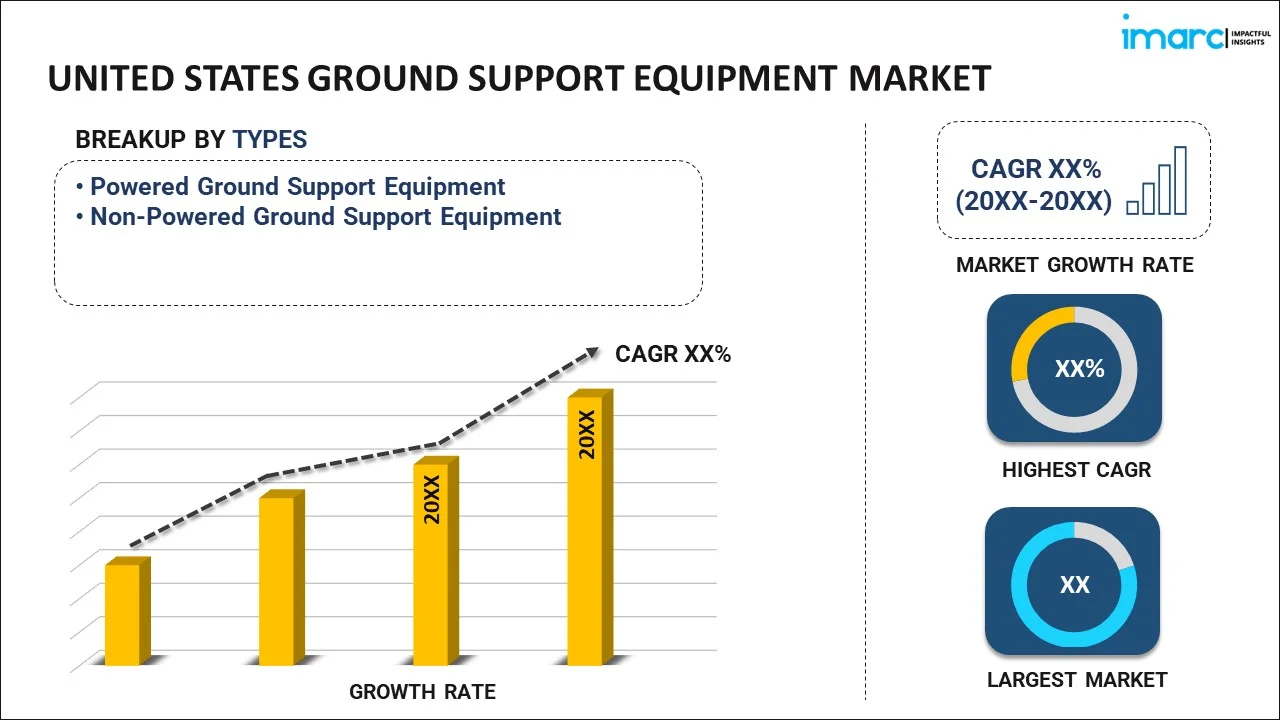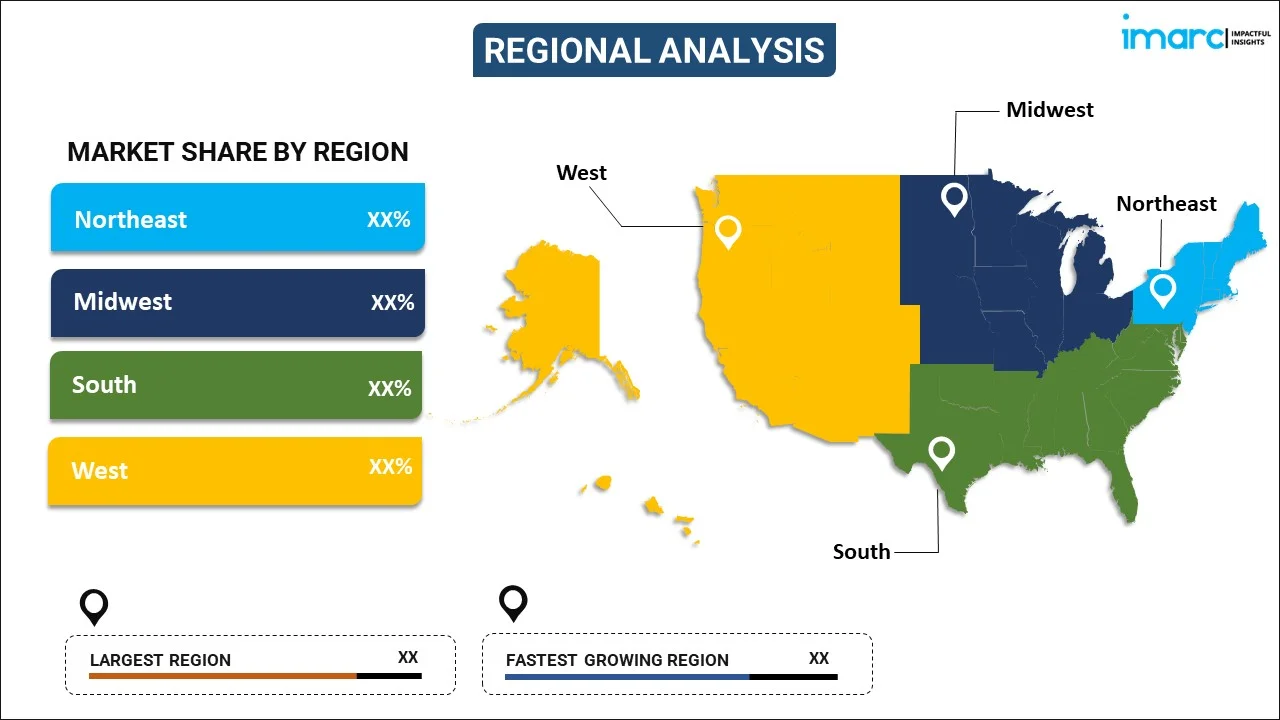
United States Ground Support Equipment Market Report by Type (Powered Ground Support Equipment, Non-Powered Ground Support Equipment), Power Source (Electric, Non-Electric, Hybrid), Application (Aircraft Handling, Passenger Handling, Cargo Handling), and Region 2025-2033
Market Overview:
United States ground support equipment market size reached USD 4.2 Billion in 2024. Looking forward, IMARC Group expects the market to reach USD 8.2 Billion by 2033, exhibiting a growth rate (CAGR) of 7.8% during 2025-2033. The rising growth in air travel and increasing air traffic, which necessitate the expansion of airport infrastructure and the acquisition of additional ground support equipment to handle the higher number of flights and passengers, is driving the market.
|
Report Attribute
|
Key Statistics
|
|---|---|
|
Base Year
|
2024 |
|
Forecast Years
|
2025-2033
|
|
Historical Years
|
2019-2024
|
| Market Size in 2024 | USD 4.2 Billion |
| Market Forecast in 2033 | USD 8.2 Billion |
| Market Growth Rate (2025-2033) | 7.8% |
Ground support equipment (GSE) refers to a diverse array of tools, vehicles, and machinery essential for the maintenance, servicing, and operation of aircraft on the ground. This equipment plays a pivotal role in ensuring the safety, functionality, and efficiency of aviation operations. GSE includes a wide range of items such as aircraft tugs, tow tractors, ground power units, air conditioning units, maintenance stands, and more. These tools are specifically designed to meet the unique requirements of different aircraft types and support various ground activities, including aircraft pushback, refueling, power supply, and maintenance tasks. GSE is crucial for facilitating rapid turnaround times between flights, minimizing downtime, and ensuring that aircraft are ready for departure with optimal performance. In summary, GSE is an indispensable component of aviation infrastructure, contributing to the smooth and safe functioning of aircraft operations while they are on the ground.
United States Ground Support Equipment Market Trends:
The ground support equipment market in the United States is experiencing robust growth, primarily driven by a surge in air travel and the expansion of aviation infrastructure regionally. As airports continue to upgrade and modernize their facilities, there is an increasing demand for advanced GSE to enhance operational efficiency. Furthermore, the rising number of commercial aircraft in service is propelling the need for innovative GSE solutions, such as automated baggage handling systems and state-of-the-art aircraft de-icing equipment. Moreover, stringent safety regulations and the emphasis on reducing turnaround times at airports are compelling stakeholders in the aviation industry to invest in cutting-edge GSE technology. The integration of smart and connected solutions in ground support equipment is another significant driver, as it allows for real-time monitoring and data analytics, optimizing maintenance schedules and minimizing downtime. Additionally, the growing focus on sustainable aviation practices is fostering the development of eco-friendly GSE alternatives. Electric and hybrid-powered ground support equipment are gaining traction, driven by environmental concerns and the industry's commitment to reducing carbon emissions. In summary, the GSE market in the United States is propelled by a confluence of factors, including the expansion of air travel, technological advancements, regulatory compliance, and a heightened focus on sustainability.
United States Ground Support Equipment Market Segmentation:
IMARC Group provides an analysis of the key trends in each segment of the market, along with forecasts at the country level for 2025-2033. Our report has categorized the market based on type, power source, and application.
Type Insights:

- Powered Ground Support Equipment
- Non-Powered Ground Support Equipment
The report has provided a detailed breakup and analysis of the market based on the type. This includes powered ground support equipment and non-powered ground support equipment.
Power Source Insights:
- Electric
- Non-Electric
- Hybrid
A detailed breakup and analysis of the market based on the power source have also been provided in the report. This includes electric, non-electric, and hybrid.
Application Insights:
- Aircraft Handling
- Passenger Handling
- Cargo Handling
The report has provided a detailed breakup and analysis of the market based on the application. This includes aircraft handling, passenger handling, and cargo handling.
Regional Insights:

- Northeast
- Midwest
- South
- West
The report has also provided a comprehensive analysis of all the major regional markets, which include the Northeast, Midwest, South, and West.
Competitive Landscape:
The market research report has also provided a comprehensive analysis of the competitive landscape in the market. Competitive analysis such as market structure, key player positioning, top winning strategies, competitive dashboard, and company evaluation quadrant has been covered in the report. Also, detailed profiles of all major companies have been provided.
United States Ground Support Equipment Market Report Coverage:
| Report Features | Details |
|---|---|
| Base Year of the Analysis | 2024 |
| Historical Period | 2019-2024 |
| Forecast Period | 2025-2033 |
| Units | Billion USD |
| Scope of the Report | Exploration of Historical and Forecast Trends, Industry Catalysts and Challenges, Segment-Wise Historical and Predictive Market Assessment:
|
| Types Covered | Powered Ground Support Equipment, Non-Powered Ground Support Equipment |
| Power Sources Covered | Electric, Non-Electric, Hybrid |
| Applications Covered | Aircraft Handling, Passenger Handling, Cargo Handling |
| Regions Covered | Northeast, Midwest, South, West |
| Customization Scope | 10% Free Customization |
| Post-Sale Analyst Support | 10-12 Weeks |
| Delivery Format | PDF and Excel through Email (We can also provide the editable version of the report in PPT/Word format on special request) |
Key Questions Answered in This Report:
- How has the United States ground support equipment market performed so far and how will it perform in the coming years?
- What has been the impact of COVID-19 on the United States ground support equipment market?
- What is the breakup of the United States ground support equipment market on the basis of type?
- What is the breakup of the United States ground support equipment market on the basis of power source?
- What is the breakup of the United States ground support equipment market on the basis of application?
- What are the various stages in the value chain of the United States ground support equipment market?
- What are the key driving factors and challenges in the United States ground support equipment?
- What is the structure of the United States ground support equipment market and who are the key players?
- What is the degree of competition in the United States ground support equipment market?
Key Benefits for Stakeholders:
- IMARC’s industry report offers a comprehensive quantitative analysis of various market segments, historical and current market trends, market forecasts, and dynamics of the United States ground support equipment market from 2019-2033.
- The research report provides the latest information on the market drivers, challenges, and opportunities in the United States ground support equipment market.
- Porter's five forces analysis assist stakeholders in assessing the impact of new entrants, competitive rivalry, supplier power, buyer power, and the threat of substitution. It helps stakeholders to analyze the level of competition within the United States ground support equipment industry and its attractiveness.
- A competitive landscape allows stakeholders to understand their competitive environment and provides an insight into the current positions of key players in the market.
Need more help?
- Speak to our experienced analysts for insights on the current market scenarios.
- Include additional segments and countries to customize the report as per your requirement.
- Gain an unparalleled competitive advantage in your domain by understanding how to utilize the report and positively impacting your operations and revenue.
- For further assistance, please connect with our analysts.
 Inquire Before Buying
Inquire Before Buying
 Speak to an Analyst
Speak to an Analyst
 Request Brochure
Request Brochure
 Request Customization
Request Customization




.webp)




.webp)












